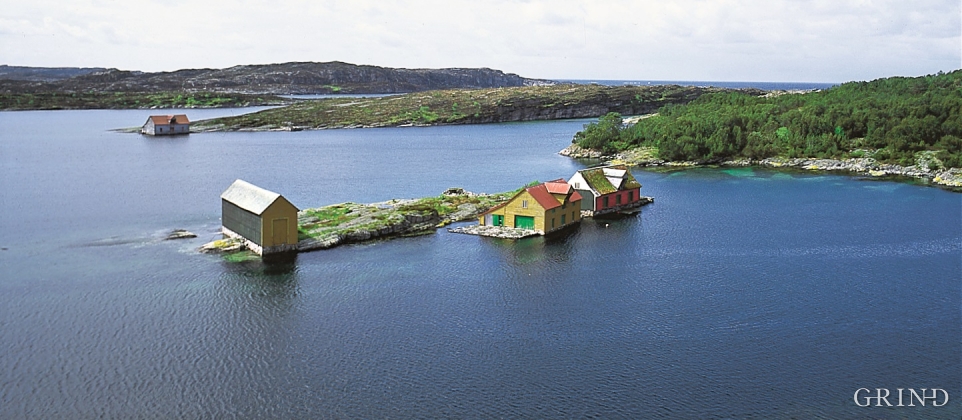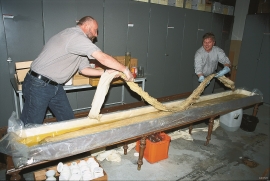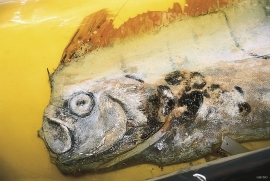Published: 31.07.2015 | Author: Stein Byrkjeland
"SEA SNAKES" AT GLESVÆR
He wondered, surely, the fisherman who in 1769 found a 3.3 metre-long silvery shining sea creature at Glesvær. Perhaps he hadn't heard the legend about the sea snake. If so, he must have thought that that was what he had found, for the sea creature resembled more a fantasy figure of a sea snake than any fish he had ever seen.
It was eventually realized that the Glesvær fisherman had come across no other than the ribbon fish, the world's biggest bony fish - not yet discovered by scientists. The experts who took over the creature were certainly in doubt as to which animal they were dealing with. In 1766, an example of this same fish had been driven into land at Glesvær. This snake-shaped fish got the name "ribbon fish" - Regalecus glesne – with the species name referring to the place where it was discovered. The fish was first described by Ascanius in the journal Icones Rerum Naturalium, which was published in Copenhagen in 1772.
About 1840, a new ribbon fish 5 metres in size was found on Golta, and one more in 1899. The latter was three and a half metres long. In March of 1791, in addition, an example that was 12 feet (ca. 4 metres) long got stranded in Bergen and was written about in "Bergen's Addresse-newspaper" the 25th of March that year. Besides these, there are been surprisingly few sightings of this species in Norway, and none since 1899.
We do not know much about the ribbon fish. With one exception, the fish has never been seen alive - those we know about, were found dead or dying various places around the world. Often, only a part of the fish is found. It can live in deep water up to 1000 metres and is found in all warm and temperate seas. In western Norway, we are in the most northerly fringes of its range. It is the Gulf Stream that is responsible for occasional sightings of fish that normally live further south, making it up into out waters. That so many ribbon fish have been found right here at Glesvær may also be due to the rich herring fishery that used to be here.
The examples that have been found here at Glesvær haven't been especially big. The world record is an 11 metre- long ribbon fish weighing 272 kilogrammes. This is also the world record for bony fish.
In the cellar of the Bergen museum, there are three ribbon fish preserved in alcohol in this especially-made tub. The biggest is 346 cm long and was found in Glesvær the 27th of January, 1899 by Knut M. Golten. The two others were found in Nord Fjord and by Alstadhaug. Zoologists Ingvar Byrkjedal (left) and Stein Byrkjeland show off the biggest of the ribbon fish.
Brown algae oarweed - valuable natural resource
The coast of western Norway and Trøndelag are the most important growing areas for the kelp-like brown algae Oarweed (Laminaria hyperborea) in the world. This brown algae has been shown to be valuable also for people. Oarweed, which can be up to four metres, grows on rocks and stony sea bottoms outermost along the coast, down to about 20 metres depth. Sund has abundant oarweed, especially on the west side. The very best area is from Lyroddane north to Telavåg, and otherwise where there is good water circulation, while at the same time being shallow enough. On a country wide basis, oarweed grows in about as large an area in the sea as is taken up by agriculture on land.
Oarweed can be transformed into alginate, a special stiffening product that gets used in foods like jelly and ice cream, and in fact also in the production of raingear, car tyres and much else. In times past, one collected this brown algae from a row boat, but nowadays one uses special algae-trawling ships. This kind of trawling is almost like a kind of undersea clear-cutting. Trawling plans have been made for the whole coast where the brown algae grows. Oarweed needs 6-8 years to grow to full size, but the catch is maximum if one harvests it every fifth year. Norway is the only country that practices kelp-trawling on a big scale.
With its numerous soft-bodied creatures, the kelp forests are very important growth areas for lobster and many other types of fish. In addition, it is a feeding area for many diving sea birds.
- Ascanius, P. 1772. Icones rerum naturalium. Bd 2.København.
- Bustnes, J. O., Christie, H.; Lorentsen, S.- H. 1997. Sjøfugl, tareskog og taretråling: en kunnskapsressurs. NINA-Oppdragsmelding 472.
- Fosså, J. H.; Sjøtun, K. 1993. Tareskogsøkologi – fisk og taretråling. Fiskets Gang 1993 (2):16–26.
- Pethon, P . 1998. Aschehougs store fiskebok. Aschehoug.






